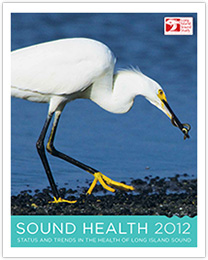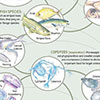Sound Health 2012
 How does Long Island Sound measure up? Find out by downloading the Sound Health 2012 report. The report looks at indicators of the Sound’s health in the areas of water quality, coastal and animal populations, climate, habitats, and land use.
How does Long Island Sound measure up? Find out by downloading the Sound Health 2012 report. The report looks at indicators of the Sound’s health in the areas of water quality, coastal and animal populations, climate, habitats, and land use.
STATUS AND TRENDS: LISS ENVIRONMENTAL INDICATORS
The Long Island Sound Study also has its full set of environmental indicators posted on the website.. [intlink id=”49″ type=”category”]Status and Trends[/intlink] includes more than 60 indicators that track environmental conditions in Long Island Sound and management’s response to improve the health of Long Island Sound.
Ordering Sound Health
To order a hard copy, log onto www.epa.gov/nscep and paste 902R12003 into the search box.
Find meanings of terms in the [intlink id=”glossary” type=”page”]glossary[/intlink].
Inside the Long Island Sound Food Web
 The cover photo of a snowy egret eating an American eel is an example of the feeding interactions that take place in the Sound. Here, one large migratory animal feeds on a smaller one at a saltwater pond in Long Island’s North Shore. LISS’s website shows a simplified[intlink id=”inside-the-long-island-sound-food-web” type=”post”] illustration[/intlink] of how the Long Island Sound food web works.
The cover photo of a snowy egret eating an American eel is an example of the feeding interactions that take place in the Sound. Here, one large migratory animal feeds on a smaller one at a saltwater pond in Long Island’s North Shore. LISS’s website shows a simplified[intlink id=”inside-the-long-island-sound-food-web” type=”post”] illustration[/intlink] of how the Long Island Sound food web works.
Have a Sound Health question?
ASK DR. K!
Send an e-mail to Jason Krumholz.. Dr. Krumholz is a marine scientist working as NOAA liaison to the EPA Long Island Sound Office, He will be selecting questions to answer on his new Sound Health blog.
Hypoxia + Nutrients

- [intlink id=”hypoxia-poster” type=”post”]What is Hypoxia? poster[/intlink]
- [intlink id=”hypoxic-dead-zones” type=”post”]What’s a Dead Zone video[/intlink]
- UN report on hypoxia and nutrient reduction
- Long Island Sound water quality monitoring program
- [intlink id=”monitoring-the-sound-slideshow” type=”post”]Monitoring the Sound slideshow[/intlink]
- Calculate your nitrogen footprint
Toxic Contaminants

- EPA Toxics Release Inventory program website
- NOAA report calls flame retardants concern to US coastal ecosystems
- “Hidden Risk: Mercury in Terrestrial Ecosystems in the Northeast“
- NYS fish consumption advisory
- CT fish consumption advisory
- [intlink id=”bioaccumulation-diagram” type=”post”]Bioaccumulation diagram[/intlink]
Conditions By Basin

Pathogens

- EPA beach closing and advisory reports
- EPA website on beach pollution
- NYSDEC information on pathogen contamination of shellfish
Coastal Debris

Shellfish

- Fish Trawl Survey report
- CT Department of Aquaculture Shellfish Program
- [intlink id=”project-limulus-horseshoe-crab-monitoring” type=”post”]Project Limulus Horseshoe Crab Monitoring Program slideshow[/intlink]
Finfish

- [intlink id=”long-island-sound-fish-trawl-survey-slide-presentation” type=”post”]Long Island Sound Fish Trawl Survey slide show[/intlink]
- Fish Trawl Survey report
- NYS fish consumption advisory
- CT fish consumption advisory
Coastal Birds

- [intlink id=”birds-of-long-island-sound” type=”post”]Birds of Long Island Sound[/intlink]
- [intlink id=”winter-birds-and-climate-change” type=”post”]Climate change and winter bird populations[/intlink]
- [intlink id=”colonial-waterbirds” type=”post”]LISS colonial waterbird indicator[/intlink]
- New York City Audubon Western Long Island Sound project website
- NYSDEC bird species fact sheets
Habitats

- [intlink id=”the-12-types-of-habitats” type=”page”]Critical Habitats of Long Island Sound[/intlink]
- [intlink id=”habitat-restoration-database” type=”page”]Habitat Restoration Database[/intlink]
- Seagrass Long Island website
- UConn CLEAR study on forest fragmentation
- 2009 Eelgrass Survey
Land and People

- UConn CLEAR’s Connecticut and Long Island Sound’s changing landscape website
- EPA “Surf Your Watershed” website
- Center for Watershed Protection report on impervious cover on aquatic systems
- [intlink id=”public-perception-survey-of-long-island-sound-watershed-residents” type=”post”]Public perception survey of Long Island Sound residents[/intlink]
- [intlink id=”stewardship” type=”page”]Long Island Sound Stewardship Initiative sites[/intlink]
What You Can Do

- [intlink id=”what-you-can-do” type=”page”]Tips on reducing pollution[/intlink]
- [intlink id=”volunteer-opportunities” type=”page”]Volunteer opportunity websites[/intlink]
- Earth 911 recycling center database
- EPA WaterSense program
